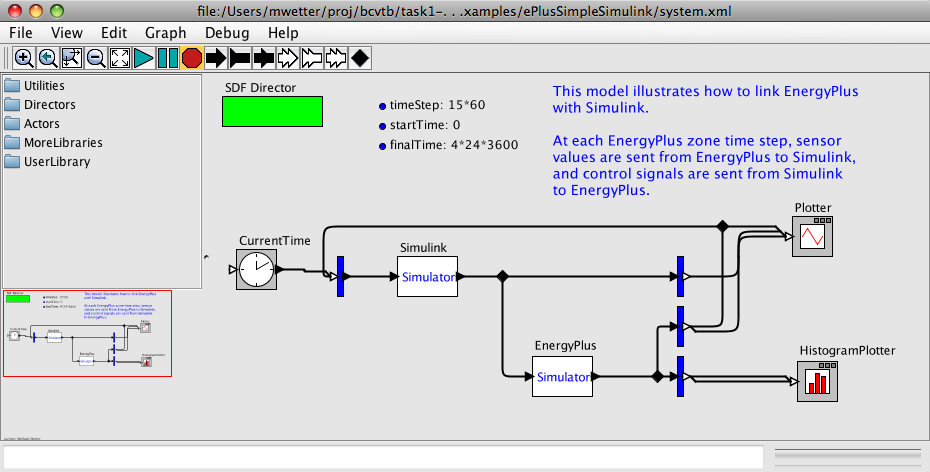|
Size: 5343
Comment:
|
Size: 5322
Comment:
|
| Deletions are marked like this. | Additions are marked like this. |
| Line 5: | Line 5: |
| ||<tablestyle="float:right;"#FFFFF0> {{attachment:ptolemyEPlusSimuMac.png||width="500"}} <<BR>> ''BCVTB system model that links !EnergyPlus with Simulink.'' <<BR>> <<BR>> '''~+News+~''' <<BR>> February 28, 2011: [[Download|Version 1.0.0]] has been released. <<BR>> February 16, 2011: A [[https://groups.google.com/group/bcvtb|mailing list]] has been started to provide support. <<BR>> <<BR>>'''~+Links+~'''<<BR>> Documentation: <<BR>> [[http://simulationresearch.lbl.gov/bcvtb/releases/latest/doc/manual/index.xhtml|Manual]] and [[http://simulationresearch.lbl.gov/bcvtb/releases/latest/doc/code/index.html|source code]]. <<BR>> [[Publications]]. <<BR>> [[GettingStarted|Download and getting started]]. <<BR>> [[Help]]. || | |
| Line 6: | Line 7: |
| ||<tablestyle="float:right;" bgcolor="#FFFFF0">{{attachment:ptolemyEPlusSimuMac.png||width=500}} <<BR>> ''BCVTB system model that links !EnergyPlus with Simulink.'' <<BR>> <<BR>> '''~+News+~''' <<BR>> February 28, 2011: [[Download|Version 1.0.0]] has been released. <<BR>> February 16, 2011: A [[https://groups.google.com/group/bcvtb|mailing list]] has been started to provide support. <<BR>> <<BR>>'''~+Links+~'''<<BR>> Documentation: <<BR>> [[http://simulationresearch.lbl.gov/bcvtb/releases/latest/doc/manual/index.xhtml|Manual]] and [[http://simulationresearch.lbl.gov/bcvtb/releases/latest/doc/code/index.html|source code]]. <<BR>> [[Publications|Publications]]. <<BR>> [[GettingStarted|Download and getting started]]. <<BR>> [[Help]]. || | |
| Line 10: | Line 10: |
| Programs that are linked to the BCVTB are * the [[http://www.energyplus.gov|EnergyPlus]] whole building energy simulation program, |
Programs that are linked to the BCVTB are * the [[http://www.energyplus.gov|EnergyPlus]] whole building energy simulation program, |
| Line 13: | Line 14: |
| * the [[http://www.mathworks.com/products/matlab|MATLAB]] and [[http://www.mathworks.com/products/simulink/|Simulink]] tools for scientific computing, | * the [[http://www.mathworks.com/products/matlab|MATLAB]] and [[http://www.mathworks.com/products/simulink/|Simulink]] tools for scientific computing, |
| Line 21: | Line 22: |
| Line 26: | Line 28: |
| Line 31: | Line 34: |
| Line 36: | Line 38: |
| Line 41: | Line 42: |
| We would also like to thank | We would also like to thank |
Building Controls Virtual Test Bed
|
The Building Controls Virtual Test Bed (BCVTB) is a software environment that allows expert users to couple different simulation programs for co-simulation, and to couple simulation programs with actual hardware. For example, the BCVTB allows to simulate a building in EnergyPlus and the HVAC and control system in Modelica, while exchanging data between the software as they simulate. The BCVTB is based on the Ptolemy II software environment. The BCVTB allows expert users of simulation to expand the capabilities of individual programs by linking them to other programs. Due to the different programs that may be involved in distributed simulation, familiarity with configuring programs is essential.
Programs that are linked to the BCVTB are
the EnergyPlus whole building energy simulation program,
the Radiance ray-tracing software for lighting analysis,
the BACnet stack, which allows exchanging data with BACnet compliant Building Automation System (BAS),
the analog/digital interface USB-1208LS from Measurement Computing Corporation that can be connected to a USB port.
In addition to using programs that are coupled to Ptolemy II, Ptolemy II's graphical modeling environment can also be used to define models for control systems, for physical devices, for communication systems or for post-processing and real-time visualization.
Typical applications of the BCVTB include:
- performance assessment of integrated building energy and controls systems,
- development of new controls algorithms, and
- formal verification of controls algorithms prior to deployment in a building in order to reduce commissioning time.
The coupling of Modelica allows using EnergyPlus for modeling the building heat flow and daylight availability and using Modelica to model innovative building energy and control systems based on the library that is currently in development at http://simulationresearch.lbl.gov/modelica. This allows advanced users to
define on the fly new HVAC components and systems in a modular, hierarchical, object-oriented, equation-based graphical modeling environment and couple them to EnergyPlus,
- innovate new HVAC system and control architectures for which models do not yet exist in off-the-shelve building simulation programs,
- analyze dynamic effects of HVAC systems, modeled in Modelica, and their local and supervisory control loops, modeled in MATLAB/Simulink, Modelica or Ptolemy, and
- simulate virtual experiments prior to full-scale testing in a laboratory or a real building in order to determine the range of required boundary conditions, the type of experiments that need to be conducted and, for example, to improve a control logic in simulation where iterations can be made faster than in an actual experiment.
Contact
Michael Wetter and Philip Haves
Lawrence Berkeley National Laboratory
Building Technologies Department
{MWetter,PHaves}@lbl.gov
Acknowledgements
This research was supported by the Assistant Secretary for Energy Efficiency and Renewable Energy, Office of Building Technologies of the U.S. Department of Energy, under Contract No. DE-AC02-05CH11231.
Special thanks go to Prof. Edward A. Lee and Christopher Brooks from the University of California at Berkeley for their support in integrating the BCVTB functionality into the Ptolemy II software.
We would also like to thank
Gregor Henze, Charles Corbin, Anthony Florita and Peter May-Ostendorp from the University of Colorado at Boulder for their contributions to the MATLAB interface and the EnergyPlus 3.0 upgrade.
Rui Zhang from Carnegie Mellon for her contributions to the Windows configuration and the EnergyPlus 3.1 upgrade.
- Zhengwei Li from the Georgia Institute of Technology for the implementation of the BACnet interface.
Andrew McNeill from LBNL for providing the Radiance example.
